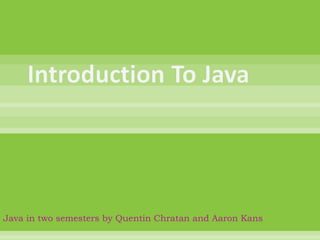
Comp102 lec 4
- 1. Java in two semesters by Quentin Chratan and Aaron Kans
- 2. public class Hello Object Oriented languages require that program is to be written in separate units called classes Telling the compiler that we are writing a class named as Hello Public indicates that we are placing this class accessible to every one A public class should always be saved in file with the same name as of the class So what will be name of our program?? Hello.java Our program will interact with multiple built in java libraries classes
- 3. {} Everything in class has to be contained between two curly brackets (Braces) to indicate the beginning and end of class Java is case sensitive Upper case letters and lower case letters are different public static void main(String[] args) Every program will have at least one class with this line This is method Main is a special method, this is where the program begins A program starts with the first instruction of main and then obeys each instruction in sequence. The program terminates when it has finished obeying the final instruction of main { } indicates the body of main and marks its starting and ending
- 4. System.out.println(“Hello World”); Display “Hello World” println is short for “print line” ; Java instruction has to end with a semi colon.
- 5. Although you can choose any name such as x, its best to pick a name that describe the purpose of data item E.g. A computer game might need a piece of data to record the player’s score as secret key. What should be the name of variable to store such data Score What should be the data type of such variable (byte, short, int and long) int You can choose any name for variable as long as The name is not already a word in java language (class, void, public) Name has no spaces in it Name does not include operators or mathematical symbols such as + or – Name starts with either a letter, an underscore (_) or a dollar sign ($) You can use any letter as starting letter but java convention is to begin the name with lower case letter
- 6. Computer Memory Java Instruction int score; hits; score, char level;
- 7. Allows values to be put into variables Written with equality symbol (=) Assignment Operator variableName = value; score =0; Set value of score to zero OR score becomes equal to zero Puts the number zero into memory we called score Combine variable statement with a variable declaration int score = 0; int score; score =0; What will be the effect of following statement in java? int score = 2.5 This statement will not compile as 2.5 is a real number
- 8. double something =1000; Though 1000 is an integer but this statement is legal as will not result in information loss. It will be considered as 1000.0 Character Assignment char level = ‘A’; Enclosed he character in single quotes Assignment at the time of declaration level =‘B’ Assignments changed
- 9. Data items in program have values that do not change Following are examples of such items Maximum score in a exam Number of hours in a day Mathematical value of (3.14176) In these cases the values do not vary Values remain constant Such items should be named and declared as constants Add the keyword “final” before declaration final int HOURS = 24 The statement HOURS = 12 will not compile now
- 10. Operation Java Operator Addition + Subtraction - Multiplication * Division / Remainder %
- 11. int x; x =10 + 25; double cost; cost = 500*(1+17.5/100); int x; x=30/4; What Will be the answer? 7 or 7.5? The answer is 7 as division operator is overloaded double price, tax, cost; price = 500; tax =17.5; cost =price+(1+tax/100); price =price+(1+tax/100);
- 12. X = X + 1; X++; X = X – 1; X--; int X = 5; int Y = 0; Postfix Prefix Y=X--; Y=X++; Y=--X; Y=++X; Y value will be 5 Y value will be 6 4 X value will be 6 4 X value will be 6 4 •Y = Y + X; •Y + = X;
- 15. System.out.println(“Hello World”); System.out.println(“Welcome to java world”); Hello World Welcome to java world System.out.print(“Hello World”); System.out.println(“Welcome to java world”); Hello WorldWelcome to java world System.out.println(); Blank line in the program
- 16. Strings Collection of characters Always enclosed in speech marks “ “ Print statements print strings Several strings can be combined using + operator Concatenation Operator (+) System.out.println(“Hello” + “World”); HelloWorld Spaces included in speech marks are printed System.out.println(“Hello ” + “World”); Hello World System.out.println(10*10); The instruction prints 100 on screen. Java converts value/expression to a string before displaying it As these numbers are converted into string so they can be combined System.out.println(“Cost = ”+(10*10)); Cost = 100
- 17. Complex data type Name Address Car Registration Number Any meaningless sequence of characters Declare it in the same was as declare variables String Name; Name = “Saira”; OR String Name = “Saira”;
- 18. Part of Java release 5.0 and later Class that makes it easy for us to write a program that obtains information that is typed in at the keyboard Scanner is part of Java package called util A package is a collection of pre-compiled classes To make Scanner class accessible to compiler, we have to tell the compiler that it should look in util package import java.util.*; * means all classes in util package are made available import java.util.Scanner; Only Scanner class is accessible
- 19. Create Object Scanner sc = new Scanner(System.in); System.in represent KeyBoard new instantiates a class by allocating memory for a new object and returning a reference to that memory. Integer Input int x; x=sc.nextInt(); Double Input double x; x=sc.nextDouble(); String Input String x; x=sc.next(); OR x=sc.nextLine(); Character Input char x; x=sc.next().charAt(0);
